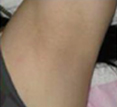
Diode Laser Hair Removal
Mode of action
The diode laser offers the optimal hair removal solution thanks to the wavelengths of 755nm and 808nm with the innovative motion scanning technology. This ideal combination offers a better absorption rate and a safe and effective treatment for permanent hair removal.
The hair has a growth cycle of anagen (growth phase), catagen (transition phase) and telogen (rest phase) and is repeated.
During the hair removal treatment, high-energy light is emitted through the skin into the hair root (follicle). The pigment melanin contained in the follicle absorbs the laser light and passes it on to the surrounding cells, which convert it into heat energy. The cells reach a temperature of around 70 degrees Celsius, which permanently damages them. As a result, the root cells are no longer able to supply the associated hair and promote its growth - existing hair falls out, new hair cannot grow back. Thanks to contact cooling and quick hair removal treatment, no use of anesthetics or gel is required.
The laser will only deactivate those hair roots that are in the growth phase, but the hair in the transition and rest phase will not be removed because they do not absorb the laser on the epidermis. To remove all hair, several sessions based on the hair cycle are needed. Depending on the type of skin and hair, it takes between six and eight sessions every four to six weeks. Thin hair or light hair that contains less melanin may require more repetitions of treatment.
- Hair Removal
- Skin Cancer
- Pacemaker
- Skin Allergies
- Pregnancy
-
Q. How does a diode laser for hair removal work?A. The laser is a pure light that emits energy. The hair absorbs this energy and passes it on to the hair roots, which are responsible for hair growth. These are destroyed so that they do not grow again.
-
Q. Is an IPL the same as a diode laser?A. A laser is not comparable to an IPL epilation system. The laser works in a much more targeted and efficient manner and thereby achieves more effective results. The time interval between treatment appointments is 4-6 weeks depending on the body zone.
-
Q. What types of skin and hair can be treated?A. The diode laser can treat all skin types according to Fitzpatrick (1-6). The suitable energy strengths are preset. With darker hair types the energy is lower and the impulses longer, with lighter types the energy strengths are higher, and the impulses are shorter. Therefore, you can also be treated with tanned skin by simply choosing the right parameters.
-
Q. Is permanent hair removal possible during pregnancy?A. Treatments with the diode laser should not be carried out during pregnancy. There are no known indications of a danger to the embryo or risks from the light used, but treatment should be discouraged for reasons of caution.
-
Q. How are body regions treated with birthmarks?A. With a diode laser treatment, the birthmarks are always best left out or covered well.
-
Q. How are body regions treated with tattoos?A. With a diode laser treatment, the tattoos are always best left out or covered well.
-
Q. How many treatments are required and for how long?A. It depends on many factors, including the affected area of the body, color, number and density of the hair, etc. As a rule, between 6 and 8 treatments are sufficient to remove 90% of the hair in the treatment area, although impressive results can be seen on the first day.
-
Q. Is hair removal with the diode laser permanent?A. Permanent does not mean "forever", what is achieved by laser depilation is a longer-term hair removal. Since many inactive hair cells are embedded in the skin, there may be isolated growths of hair follicles that have not yet been treated; new hair cells can also develop after hormonal fluctuations and pregnancies.
-
Q. Is the treatment uncomfortable?A. At first, the skin on which the laser head rests can only feel cold, comparable to touching ice. This is triggered by the cooling system. The laser is then activated. You can feel a slight pull, comparable to plucking hair with tweezers.
-
Q. Can there be side effects?A. Side effects in most cases are excluded due to a correctly collected anamnesis but depending on the sensitivity there may be redness around the hair follicle, this redness disappears after 1-2 days. In very few cases there are pigment disorders.
-
Q. What needs to be considered before treatment?A. To be able to carry out a treatment, hair must be available. Consequently, the hair must not be removed by plucking, waxing, epilation, depilation during the treatment period. Plucking or waxing the hair should be stopped 6 weeks before the treatment. However, shaving the hair can be done. Sun tanning, solarium and self-tanning creams should be avoided about 3 weeks before the treatment in order not to jeopardize the success of the treatment.
-
Q. What should be considered after the treatment?A. Since the natural sun protection of the skin falls off due to the intensive light treatment, a sun protection cream with an SPF 50 should be applied for one week after treatment. The remaining hair only falls out after 1 to 4 weeks, this varies individually.
Results

BEFORE

AFTER

BEFORE

AFTER

BEFORE

AFTER
Facts
- Effective and safe
- No downtime
- Non-invasive
- Low pain
- Fast and efficient treatment results
- Spot size of 15x50mm
- Continuous contact cooling through sapphire cooling
- Duration of treatment 10 - 60 minutes
- Permanent hair removal after 6 - 8 sessions








